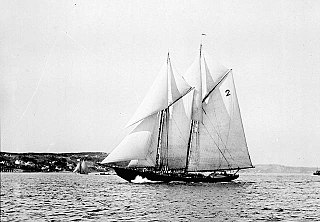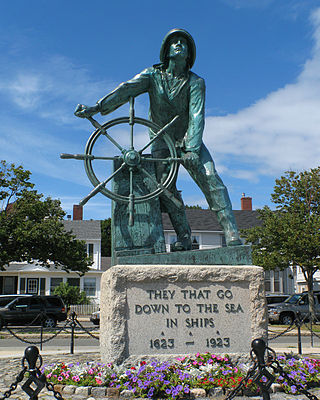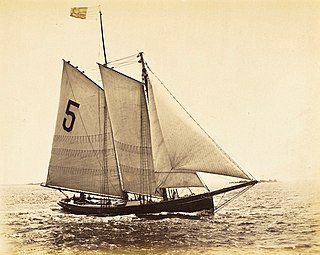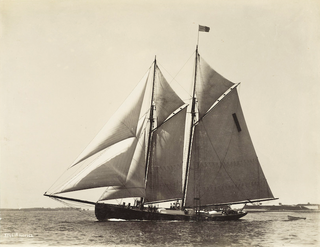Related Research Articles

Bluenose was a fishing and racing gaff rig schooner built in 1921 in Lunenburg, Nova Scotia, Canada. A celebrated racing ship and fishing vessel, Bluenose under the command of Angus Walters, became a provincial icon for Nova Scotia and an important Canadian symbol in the 1930s, serving as a working vessel until she was wrecked in 1946. Nicknamed the "Queen of the North Atlantic", she was later commemorated by the Bluenose one-design sloop (1946) and a replica, Bluenose II (1963). The name Bluenose originated as a nickname for Nova Scotians from as early as the late 18th century.

Gloucester is a city in Essex County, Massachusetts, United States. It sits on Cape Ann and is a part of Massachusetts's North Shore. The population was 29,729 at the 2020 U.S. Census. An important center of the fishing industry and a popular summer destination, Gloucester consists of an urban core on the north side of the harbor and the outlying neighborhoods of Annisquam, Bay View, Lanesville, Folly Cove, Magnolia, Riverdale, East Gloucester, and West Gloucester.

Effie M. Morrissey is a schooner skippered by Robert Bartlett that made many scientific expeditions to the Arctic, sponsored by American museums, the Explorers Club and the National Geographic Society. She also helped survey the Arctic for the United States Government during World War II. She is currently designated by the United States Department of the Interior as a National Historic Landmark as part of the New Bedford Whaling National Historical Park. She is the State Ship of Massachusetts.
The Delawana was a fishing schooner based in Riverport, Nova Scotia.
Martin Leander Welch (1864–1935) was a fishing schooner captain out of Gloucester, Massachusetts. He was captain of the Esperanto in 1920 when it defeated the Canadian schooner Delawana in the first International Fishing Schooner Championship Races in Halifax, Nova Scotia.

Adventure is a gaff rigged knockabout schooner. She was built in Essex, Massachusetts, USA, and launched in 1926 to work the Grand Banks fishing grounds out of Gloucester. She is one of only two surviving knockabout fishing schooners – ships designed without bowsprits for the safety of her crew.

Lettie G. Howard, formerly Mystic C and Caviare, is a woodenFredonia schooner built in 1893 in Essex, Massachusetts. This type of craft was commonly used by American offshore fishermen, and is believed to be the last surviving example of its type. She was declared a National Historic Landmark in 1989. She is now based at the South Street Seaport Museum in New York City.

L. A. Dunton is a National Historic Landmark fishing schooner and museum exhibit located at the Mystic Seaport Museum in Mystic, Connecticut. Built in 1921, she is one of three remaining vessels afloat of this type, which was once the most common sail-powered fishing vessel sailing from New England ports. In service in New England waters until the 1930s and Newfoundland into the 1950s. After a brief period as a cargo ship, she was acquired by the museum and restored to her original condition.
The A. T. Gifford was the last American schooner-rigged whaleship to cruise Hudson Bay. She caught fire and sank in late 1915. Although the captain and a few of his crew escaped the wreck, none survived the disaster.

USS Liberty III (SP-1229), sometimes written Liberty # 3, and also referred to during her naval career as Liberty and as Pilot Boat Liberty, No. 3, was a United States Navy patrol vessel in commission from 1917 to 1919. The Liberty was a pilot boat from 1896-1917. She was a replacement for the pilot boat D. J. Lawlor. After World War I, the Liberty returned to pilot service until 1934 when she was purchased as a yacht.

Gertrude L. Thebaud was an American fishing and racing schooner built and launched in Essex, Massachusetts in 1930. A celebrated racing competitor of the Canadian Bluenose, it was designed by Frank Paine and built by Arthur D. Story for Louis A. Thebaud, and named for his wife, Gertrude Thebaud. In their first meeting at Gloucester, Massachusetts in October 1930, Gertrude L. Thebaud bested Bluenose 2-0 to win the Sir Thomas Lipton International Fishing Challenge Cup. However, in 1931, two races to none, and again in 1938, three races to two, Bluenose defeated Gertrude L. Thebaud to remain the undefeated holder of the International Fisherman's Trophy. During World War II, the schooner saw service with the United States Coast Guard. The vessel sank in 1948 off the coast of Venezuela.

Angus James Walters was a sailor and sea captain who skippered the famed Grand Banks fishing schooner Bluenose from 1921 to 1938. Walters captained Bluenose to five international sailing championships, and was undefeated for seventeen years.

Richard Moses Murphy (1838–1916) was a well-known schooner captain who sailed out of Gloucester, Massachusetts, during the late 19th-century. Some of his experiences as a mariner are detailed in a chapter titled "The Adventures of Captain Richard Murphy" in The Fisherman’s Own Book, published by Proctor Brothers in 1882.
The Columbia was an American schooner, a fishing vessel launched in 1923. She took part in several races, and subsequently disappeared off Nova Scotia in 1927. A replica was built in 2014.

The Sylph was a 19th-century pilot boat first built in 1834, by Whitmore & Holbrook for John Perkins Cushing as a Boston yacht and pilot-boat for merchant and ship owner Robert Bennet Forbes. She won the first recorded American yacht race in 1835. She was a pilot boat in the Boston Harbor in 1836 and 1837 and sold to the New York and Sandy Hook Pilots in October 1837. She was lost in winter of 1857 with all hands during a blizzard off Barnegat, New Jersey. The second Sylph was built in 1865 from a half-model by Dennison J. Lawlor. The third Sylph was built in 1878 at North Weymouth, Massachusetts for Boston Pilots. She was sold out of service in 1901, after 23 years of Boston pilot service.

James H. Reid, was a 19th-century American Maritime pilot. He is best known for being the dean of the Boston pilots, serving for 55 years. He was captain of the famous yacht America for 17 years when she was owned by Benjamin F. Butler. In 1897, he built a new America, named after the America's Cup defender.

The Hesper was a 19th-century Boston pilot boat built in 1884, designed from a model by Dennison J. Lawlor as a Boston yacht and pilot-boat for merchant and ship owner George W. Lawler. She was known to be the largest pilot boat under the American flag at 104 feet long and the fastest of the Boston fleet. She competed in several first-class sailing races, and in 1886, the Hesper won the silver cup in what was known as the first Fishermen's Race. She was withdrawn from the pilot service and sold in 1901. The Hesper became a wreck on the point off Cape Henlopen in 1919.

Thomas Francis McManus was a fish merchant who became a naval architect, who introduced a shortened bowsprit and long stern overhang to make his vessels faster. He was well known for revolutionizing the Gloucester fishing schooner. He made the fastest vessels of their type in the world, and was honored on two continents for his skill as a naval architect. He became known as the "Father of the Fishermen's Races." 500 fishing schooners used his designs to improve speed. He was a friend of Sir Thomas Lipton and President Theodore Roosevelt.

The America, No. 1 was a 19th-century American pilot boat built in 1897 for Captain James H. Reid Sr. of Boston and designed by Boston designer Thomas F. McManus. The Boston America did not resemble her famous namesake, yacht America, rather she was designed with a fishing schooner "Indian header" bow. After serving 21 years in the Boston Pilots' Association, the America was sold to David W. Simpson of Boston in 1918.

Moses Adams, was an Essex County shipbuilder. He had his own shipyard and built eighty-five schooners and pilot boats. Adams died in Essex, Massachusetts in 1894.